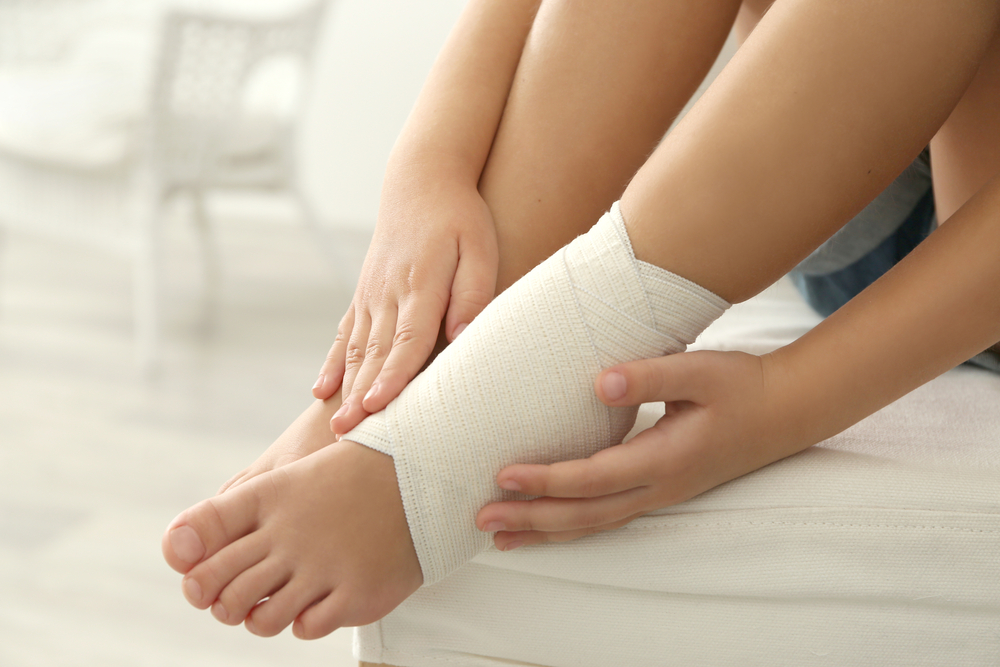Items filtered by date: July 2021
Two Ways an Ingrown Toenail Can Develop
 The two ways an ingrown toenail can develop consists of the nail growing into the skin or it can grow over the nail. A common reason for this condition to occur includes improper trimming of the toenails. They may curl and dig under the skin, possibly causing the nail and surrounding area to become red and swollen. In severe cases the affected nail may become infected and pus could ooze out. Additionally, some patients wear shoes that do not have adequate room for the toes to move freely in and this may cause the toenails to become ingrown. Relief may be found when the nail is soaked in warm water and this can make it easier to pull the nail away from the skin using a piece of cotton. It is strongly suggested that you seek the counsel of a podiatrist who can properly manage this condition if you have an ingrown toenail or recurring ingrown toenails.
The two ways an ingrown toenail can develop consists of the nail growing into the skin or it can grow over the nail. A common reason for this condition to occur includes improper trimming of the toenails. They may curl and dig under the skin, possibly causing the nail and surrounding area to become red and swollen. In severe cases the affected nail may become infected and pus could ooze out. Additionally, some patients wear shoes that do not have adequate room for the toes to move freely in and this may cause the toenails to become ingrown. Relief may be found when the nail is soaked in warm water and this can make it easier to pull the nail away from the skin using a piece of cotton. It is strongly suggested that you seek the counsel of a podiatrist who can properly manage this condition if you have an ingrown toenail or recurring ingrown toenails.
Ingrown toenails can become painful if they are not treated properly. For more information about ingrown toenails, contact Matthew McQuaid, DPM of Lake Mendocino Podiatry. Our doctor can provide the care you need to keep you pain-free and on your feet.
Ingrown Toenails
Ingrown toenails occur when a toenail grows sideways into the bed of the nail, causing pain, swelling, and possibly infection.
Causes
- Bacterial infections
- Improper nail cutting such as cutting it too short or not straight across
- Trauma to the toe, such as stubbing, which causes the nail to grow back irregularly
- Ill-fitting shoes that bunch the toes too close together
- Genetic predisposition
Prevention
Because ingrown toenails are not something found outside of shoe-wearing cultures, going barefoot as often as possible will decrease the likeliness of developing ingrown toenails. Wearing proper fitting shoes and using proper cutting techniques will also help decrease your risk of developing ingrown toenails.
Treatment
Ingrown toenails are a very treatable foot condition. In minor cases, soaking the affected area in salt or antibacterial soaps will not only help with the ingrown nail itself, but also help prevent any infections from occurring. In more severe cases, surgery is an option. In either case, speaking to your podiatrist about this condition will help you get a better understanding of specific treatment options that are right for you.
If you have any questions please feel free to contact our offices located in Lakeport and Ukiah, CA . We offer the newest diagnostic and treatment technologies for all your foot and ankle needs.
Recovering From Tenosynovitis
Tenosynovitis is an inflammation of a tendon and its synovium, or lining. This condition can affect the feet or ankles and occur due to injury, repetitive overuse, excessive pressure on the tendon, or an infection. Tenosynovitis usually affects athletes, ballet dancers, and older adults. While recovering from this condition, it is suggested that you limit your leg and foot movement to decrease stress on the tendon and prevent further damage. Applying ice or heat to the area can help reduce swelling and pain. At home, you may need to wear a splint, brace, or walking boot, and may need crutches to get around. It is important to follow your doctor’s instructions so that you can recover fully and return to your usual activities as soon as possible. If you are experiencing ankle pain, please consult with a podiatrist.
Ankle pain can have many different causes and the pain may potentially be serious. If you have ankle pain, consult with Matthew McQuaid, DPM from Lake Mendocino Podiatry. Our doctor will assess your condition and provide you with quality foot and ankle treatment.
Ankle pain is any condition that causes pain in the ankle. Due to the fact that the ankle consists of tendons, muscles, bones, and ligaments, ankle pain can come from a number of different conditions.
Causes
The most common causes of ankle pain include:
- Types of arthritis (rheumatoid, osteoarthritis, and gout)
- Ankle sprains
- Broken ankles
- Achilles tendinitis
- Achilles tendon rupture
- Stress fractures
- Tarsal tunnel syndrome
- Plantar fasciitis
Symptoms
Symptoms of ankle injury vary based upon the condition. Pain may include general pain and discomfort, swelling, aching, redness, bruising, burning or stabbing sensations, and/or loss of sensation.
Diagnosis
Due to the wide variety of potential causes of ankle pain, podiatrists will utilize a number of different methods to properly diagnose ankle pain. This can include asking for personal and family medical histories and of any recent injuries. Further diagnosis may include sensation tests, a physical examination, and potentially x-rays or other imaging tests.
Treatment
Just as the range of causes varies widely, so do treatments. Some more common treatments are rest, ice packs, keeping pressure off the foot, orthotics and braces, medication for inflammation and pain, and surgery.
If you have any questions, please feel free to contact our offices located in Lakeport and Ukiah, CA . We offer the newest diagnostic and treatment technologies for all your foot care needs.
What Is Tenosynovitis?
 Tenosynovitis is an inflammation of a tendon and its synovium, or lining. This condition can affect the feet or ankles and occurs due to injury, repetitive overuse, excessive pressure on the tendon, or an infection. Symptoms of tenosynovitis in the lower limbs include pain, redness, or swelling, clicking, locking, or snapping in the affected foot or ankle, a grating sound or feeling, stiffness, weakness, and limited range of motion. When tenosynovitis affects the toes, there may be a noticeable bump on the toe. If you are experiencing the symptoms of this condition anywhere around your feet and ankles, it is suggested that you see a podiatrist for treatment.
Tenosynovitis is an inflammation of a tendon and its synovium, or lining. This condition can affect the feet or ankles and occurs due to injury, repetitive overuse, excessive pressure on the tendon, or an infection. Symptoms of tenosynovitis in the lower limbs include pain, redness, or swelling, clicking, locking, or snapping in the affected foot or ankle, a grating sound or feeling, stiffness, weakness, and limited range of motion. When tenosynovitis affects the toes, there may be a noticeable bump on the toe. If you are experiencing the symptoms of this condition anywhere around your feet and ankles, it is suggested that you see a podiatrist for treatment.
Sports related foot and ankle injuries require proper treatment before players can go back to their regular routines. For more information, contact Matthew McQuaid, DPM of Lake Mendocino Podiatry. Our doctor can provide the care you need to keep you pain-free and on your feet.
Sports Related Foot and Ankle Injuries
Foot and ankle injuries are a common occurrence when it comes to athletes of any sport. While many athletes dismiss the initial aches and pains, the truth is that ignoring potential foot and ankle injuries can lead to serious problems. As athletes continue to place pressure and strain the area further, a mild injury can turn into something as serious as a rupture and may lead to a permanent disability. There are many factors that contribute to sports related foot and ankle injuries, which include failure to warm up properly, not providing support or wearing bad footwear. Common injuries and conditions athletes face, including:
- Plantar Fasciitis
- Plantar Fasciosis
- Achilles Tendinitis
- Achilles Tendon Rupture
- Ankle Sprains
Sports related injuries are commonly treated using the RICE method. This includes rest, applying ice to the injured area, compression and elevating the ankle. More serious sprains and injuries may require surgery, which could include arthroscopic and reconstructive surgery. Rehabilitation and therapy may also be required in order to get any recovering athlete to become fully functional again. Any unusual aches and pains an athlete sustains must be evaluated by a licensed, reputable medical professional.
If you have any questions please feel free to contact our offices located in Lakeport and Ukiah, CA . We offer the newest diagnostic and treatment technologies for all your foot and ankle needs.
What is Tarsal Tunnel Syndrome?
The tarsal tunnel is a narrow structure on the inside of the ankle, which lies next to the ankle bones. Nerves, arteries, veins, and tendons pass through the tarsal tunnel. The tibial nerve, which runs down the back of the leg, eventually makes its way through the tarsal tunnel to innervate the sole of the foot. When the tibial nerve gets compressed or squeezed within the tarsal tunnel, it can produce pain, tingling, burning, or numbness along its path in the foot. Typical causes of tarsal tunnel syndrome include an injury to the ankle that causes inflammation near the tunnel, undue strain on the tibial nerve due to flat feet, something enlarged within the tarsal tunnel (such as a swollen vein, tendon, or cyst), and systemic diseases that cause swelling, such as arthritis and diabetes. If you believe you may have tarsal tunnel syndrome, early diagnosis and treatment from a podiatrist can help relieve your pain, halt the progression of the disorder, and prevent possible permanent nerve damage.
Tarsal tunnel syndrome can be very uncomfortable to live with. If you are experiencing tarsal tunnel syndrome, contact Matthew McQuaid, DPM of Lake Mendocino Podiatry. Our doctor can provide the care you need to keep you pain-free and on your feet.
Tarsal Tunnel Syndrome
Tarsal tunnel syndrome, which can also be called tibial nerve dysfunction, is an uncommon condition of misfiring peripheral nerves in the foot. The tibial nerve is the peripheral nerve in the leg responsible for sensation and movement of the foot and calf muscles. In tarsal tunnel syndrome, the tibial nerve is damaged, causing problems with movement and feeling in the foot of the affected leg.
Common Cause of Tarsal Tunnel Syndrome
- Involves pressure or an injury, direct pressure on the tibial nerve for an extended period of time, sometimes caused by other body structures close by or near the knee.
- Diseases that damage nerves, including diabetes, may cause tarsal tunnel syndrome.
- At times, tarsal tunnel syndrome can appear without an obvious cause in some cases.
The Effects of Tarsal Tunnel Syndrome
- Different sensations, an afflicted person may experience pain, tingling, burning or other unusual sensations in the foot of the affected leg.
- The foot muscles, toes and ankle become weaker, and curling your toes or flexing your foot can become difficult.
- If condition worsens, infections and ulcers may develop on the foot that is experiencing the syndrome.
A physical exam of the leg can help identify the presence of tarsal tunnel syndrome. Medical tests, such as a nerve biopsy, are also used to diagnose the condition. Patients may receive physical therapy and prescriptive medication. In extreme cases, some may require surgery.
If you have any questions please feel free to contact our offices located in Lakeport and Ukiah, CA . We offer the newest diagnostic and treatment technologies for all your foot and ankle needs.



